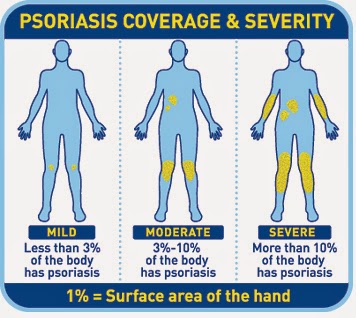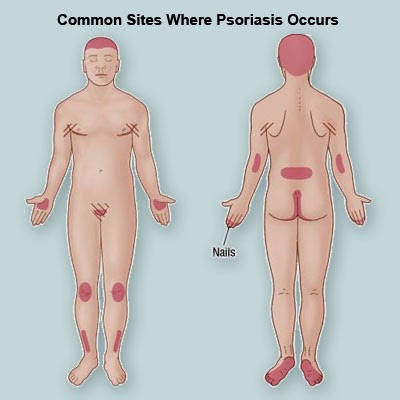The
signs and symptoms of the different types of psoriasis are:
Plaque psoriasis
¬ Raised, inflamed, red lesions (plaques) covered in a silvery
white scale
¬ Typically found on the elbows, scalp, knees and lower back. They
can, however, appear anywhere on the surface of the body.
¬ Plaques are typically itchy, sore (or both).
¬ Skin around the joints may crack and bleed in severe cases.
Nail psoriasis
v Yellow-red
nail discoloring. It likes
like a drop of oil (or blood) under the nail plate. Health care professionals
sometimes refer to this as an oil drop or salmon patch.
v Pits in the
nails, also known as pitting of the
nail matrix. Pitting is the result of the loss of cells from the surface of the
nail.
v Lines across
the nails – often referred to as Beau
line by health care professionals. The lines go side-to-side, rather than from
top-to-bottom. The lines are caused by inflammation of the cells.
v Leukonychia
(midmatrix disease) – areas of
white on the nail plate.
v Subungual
hyperkeratosis – the skin under the
nail thickens.
v The nail
loosens – health care professionals
may use the terms onycholysis of the nail bed and nail hyponychium. Where the
nail separates from the skin under it, a white area may develop, starting at
the nail’s tip and extending downwards. The skin under the nail (nail bed) may
become infected.
v Nail
crumbling – health care professionals
may refer to nail plate crumbling at the nail bed or nail matrix. As the
structures that support the nail are not working properly, the nail weakens.
v Splinter
hemorrhage – also known as dilated
tortuous capillaries in the dermal papillae. These are small black lines that
go from the tip of the nail to the cuticle. Tiny capillaries (very small blood
vessels) between the nail and the skin under it bleed, causing the lines to
appear.
v Spotted
lunula – the lunula is the
crescent-shaped whitish area of the bed of a fingernail or toe. It is the visible
part of the nail matrix (root of the nail). The lunula becomes red when the
capillaries under the nail are congested.
v Nail changes
with arthritis of the fingers – at least
half of all patients with psoriatic arthritis experiences nail changes.
v Onychomycosis – this is a fungal infection of the nails. Sometimes linked to
nail psoriasis.
v Paronychia – inflammation of the folds of tissue around the nail, caused
by an infection. It may be a bacteria (staph or strep) or fungal infection.
Sometimes linked to nail psoriasis.
Guttate psoriasis
 Sometimes
known as teardrop psoriasis or raindrop psoriasis.
Sometimes
known as teardrop psoriasis or raindrop psoriasis.
Ø Plaques are usually small, no more than 1cm in diameter.
Ø Plaques are fairly widespread. They may develop anywhere in the
body, except the soles of the feet and palms of the hands. Most commonly
affects the chest, arms, legs and scalp.
Ø Some signs and symptoms of nail psoriasis may also be present.
Ø Usually occurs after a strep infection (throat infection) and is
more common among teenagers and children.
Ø There is a good likelihood that the guttate psoriasis eventually
disappears completely. However, some young patients eventually develop plaque
psoriasis.
Scalp psoriasis
ü Usually affects the back of the head. However, it can occur on
the whole scalp, or other parts of the scalp.
ü Red patches of skin
ü The red patches are covered in thick silvery-white scales.
ü Can be extremely itchy (sometimes it isn’t itchy).
ü Can cause hair loss in severe cases.
Inverse psoriasis (Flexural psoriasis)
More
common among overweight/obese individuals
¬ As opposed to plaque psoriasis, inverse psoriasis is not
characterized by scaling.
¬ Inverse psoriasis is characterized by inflamed, bright red,
smooth patches of skin.
¬ Can be very itchy
¬ Can be very painful
¬ If the skin rubs together in the folds, symptoms will be
aggravated.
¬ Sweating in the skin folds may also aggravate affected areas.
¬ Most commonly affected areas include the armpits, groin, skin
between the buttocks, and skin under the breasts.
¬ In obese/overweight patients, there may be symptoms under the
belly (where it folds over).
Pustular psoriasis
A
much rarer type of psoriasis. There are three main types, and they affect
different areas of the body:
Von Zumbusch psoriasis
Ø Pustules appear across a wide area of skin
Ø Pustules develop rapidly
Ø The pus is made up of white blood cells
Ø The pus is not infected
Ø Within a couple of days the pustules dry and peel off, after
which the skin is shiny and smooth
Ø Pustules may appear in cycles of weeks, or even a few days
Ø At the start of a cycle the patient may experience fever,
chills, fatigue and weight loss
Palma planter pustular psoriasis
v Pustules may appear on the soles of feet or the palms of the
hands
v Pustules develop into round, brown, scaly sports
v Pustules eventually dry and peel off
v There may be cycles of recurrence, every few weeks or even days
v Acropustulosis
v Pustules appear on fingers and/or toes
v Pustules burst
v Burst pustules leave bright red areas that may become scaly, or
v Burst pustules leave bright red areas that ooze
v Sometimes symptoms of nail psoriasis appear
Erythrodermic psoriasis
It is
the most uncommon form of psoriasis.
¬ Whole body can be covered with a fiery red rash
¬ There is usually intense itching
¬ There is typically an intense burning sensation
¬ There is widespread inflammation
¬ There is widespread exfoliation (shedding of skin), during which
time itching, burning and swelling is more severe.
¬ Body more susceptible to losing proteins and fluid, leading to
dehydration and malnutrition (as well as heart failure).
¬ Hypothermia is possible – the patient’s body temperature becomes
too low; 35C (95 F) or below.
Psoriatic arthritis
The majorities
of patients develops psoriasis first, and are diagnosed with psoriatic
arthritis at a later date. However, arthritis may sometimes develop before the
skin lesions appear.
ü Joint pain
ü Stiffness, especially first thing in the morning, or after
resting
ü Redness, swelling around the affected joints and tendons
ü Finger(s) swells around the affected joints and tendons
ü Reduced range of movement at the affected joint
ü Symptoms of nail psoriasis
ü Flaking silver patches of skin. Inflammation under the skin,
usually red
ü Iritis – inflammation of the iris. The eye becomes reddened.
There may be sensitivity to light.
ü Uveitis - inflammation involving the uvea - the iris, choroid,
and ciliary body (parts of the eye). Symptoms may include redness of the eye,
blurred vision, unusual sensitivity to light, and eye pain.
ü Inflammation of the skin and the symptoms of psoriasis
ü Spondylitis - inflammation of one or more of the vertebrae of
the spine. Inflammation can also occur where ligaments and tendons attach to
your spine. Symptoms may include pain and stiffness in the lower back, upper
buttock area, neck, and the rest of the spine. Symptoms are usually worse on
waking up, or after long periods of inactivity.
==--==



No comments:
Post a Comment